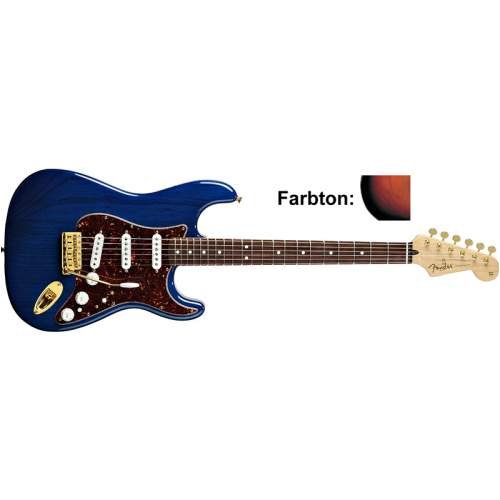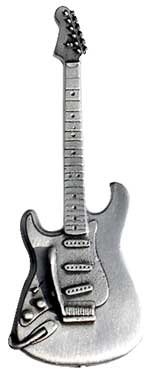 Electric Guitar. Made by Fender.
Electric Guitar. Made by Fender.The Deluxe Players Stratocaster is a revised version of the former Super Strat. Upgraded with American-made Vintage Noiseless pickups, this guitar not only sounds great but with a 12" neck radius and medium jumbo frets it's a workhorse of a guitar! And, don't forget about the push button switch that gives the player nine different pickup combinations!
Features:
- BODY Ash
- NECK Maple, Modern "C" Shape, (Satin Polyurethane Finish)
- MACHINE HEADS Gold Plated Fender/Reliance Vintage Style Tuning Machines
- FINGERBOARD Rosewood, 12" Radius (305mm)
- NO. OF FRETS 21 Medium Jumbo Frets
- PICKUPS 3 Vintage Noiseless Strat Pickups
- CONTROLS Master Volume, Tone 1. (Neck Pickup), Tone 2. (Middle Pickup)
- BRIDGE Gold Plated Vintage Style Synchronized Tremolo
- PICKUP SWITCHING 5-Position Blade: Position 1. Bridge Pickup, Position 2. Bridge and Middle Pickup, Position 3. Middle Pickup, Position 4. Middle and Neck Pickups (Plus Bridge Pickup When Push/Push Switch Is Activated), Position 5. Neck Pickup (Plus Bridge Pickup When Push/Push Switch Is Activated), 1-Push-Button On/Off Switch: Activates Bridge Pickup in Positions 4 and 5 of Blade Switch
- HARDWARE Gold Plated
- STRINGS Fender Super Bullet 3250L, Nickel Plated Steel, (.009 to .042)
- CASE Deluxe Gig Bag
- PICKGUARD 4-Ply Brown Shell
- SCALE LENGTH 25.5" (648mm)
- WIDTH AT NUT 1 11/16 (43mm)
- UNIQUE FEATURES Gold Plated Hardware
- ACCESSORIES Deluxe Gig Bag
NOTE: The picture on this page shows the Maple version of this guitar model, if you place an order from this page you will receive the model with a Rosewood fretboard
Most of us who play blues guitar are familiar with the 12 bar blues. Almost every blues guitar player has played songs like Sweet Home Chicago, Pride and Joy, Red House, and one of the thousands of other blues songs that use the 12 bar form. What many blues guitar players dont know, is that there are two other great blues forms to choose from, the 8 bar blues, and the 16 bar blues.
All of the forms use only three chords, and roman numerals are used to describe them. The first chord, called the I chord, is usually a dominant seventh type of chord that is built from the first note in the major scale. If you are in the key of G, then G7 will be your I chord. The fourth note of a G major scale is a C, so the next chord used is called the IV chord and would be C7 in the key of G. The fifth note in the G major scale is D, so the V chord would be D7. So now you have your three primary chords, G7, C7, and D7.
The 12 bar blues is 12 measures long. The term bar is just another word for measure. The first bar is always the I chord. The second bar is either the I chord again, or for a quick change blues, it is the IV chord. Bars 3 and 4 are always the I chord again. Bars 5 and 6 will be the IV chord, and bars 7 and 8 will be the I chord. Bar 9 is the V chord, but bar 10 will either be IV or V. Bar 11 is the I chord, and Bar 12 is the V chord which sets up the listener for the start of the next chorus.
The 8 bar blues, as in the song Key To The Highway, also starts with a I chord. After that, Bar 2 is the V chord. Bars 3 and 4 belong to the IV chord. Bar 5 is back to the I chord. Bar 6 is the V. Bars 7 and 8 repeat that sentiment with the I chord on Bar 7 and the V chord on bar 8. Once again, the final bar has the V chord to setup for the next chorus.
A 16 bar blues, such as the Herbie Hancock tune, Watermelon Man, starts like a 12 bar blues. The first four bars are the I chord. Bars 5 and 6 the IV chord, and bars 7 and 8 return to the I chord. Even bars 9 and 10 share the V and IV chord usage like the 12 bar blues. The difference is in that bars 9 and 10 are repeated 2 more times for Bars 11 14. Finally, bar 15 returns to the I chord which also holds on for bar 16.
As a blues guitar player, remember that its not that important how you play the chords in a blues tune. You can play the same tune with several different comping styles and get several great results for the same tune. Similarly, when you find a good comping pattern that you like, dont be afraid to stick with it for a lot of the tunes that you play. If it works well in one tune, chances are it will work well in others.
Griff Hamlin is a professional musician, guitar teacher, and author. He runs several websites, including Playing Through The Blues, a method for learning blues guitar
john mayer fender stratocaster